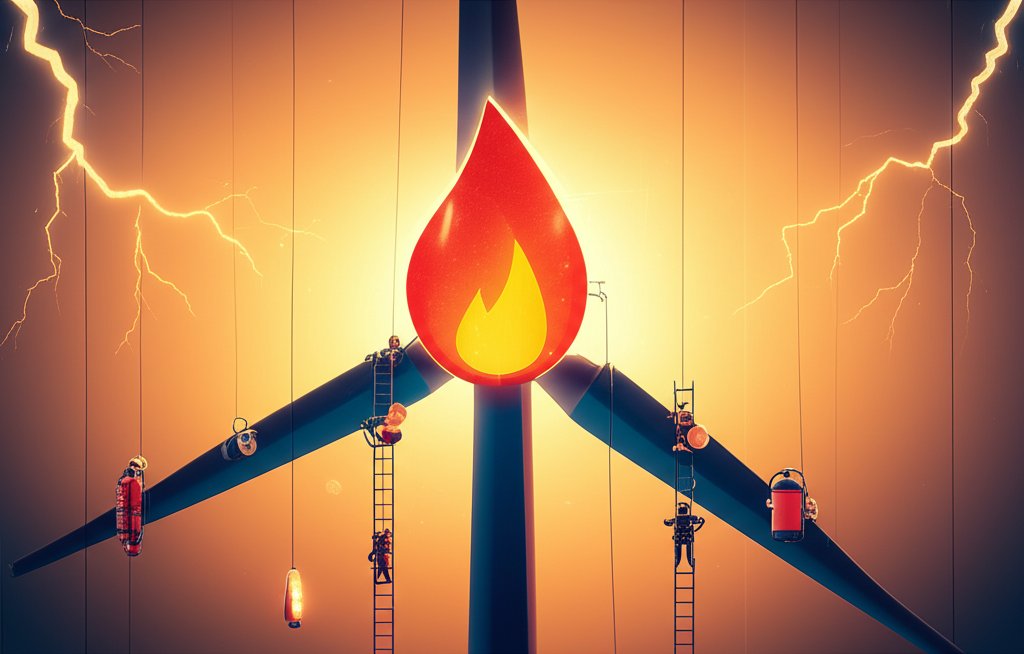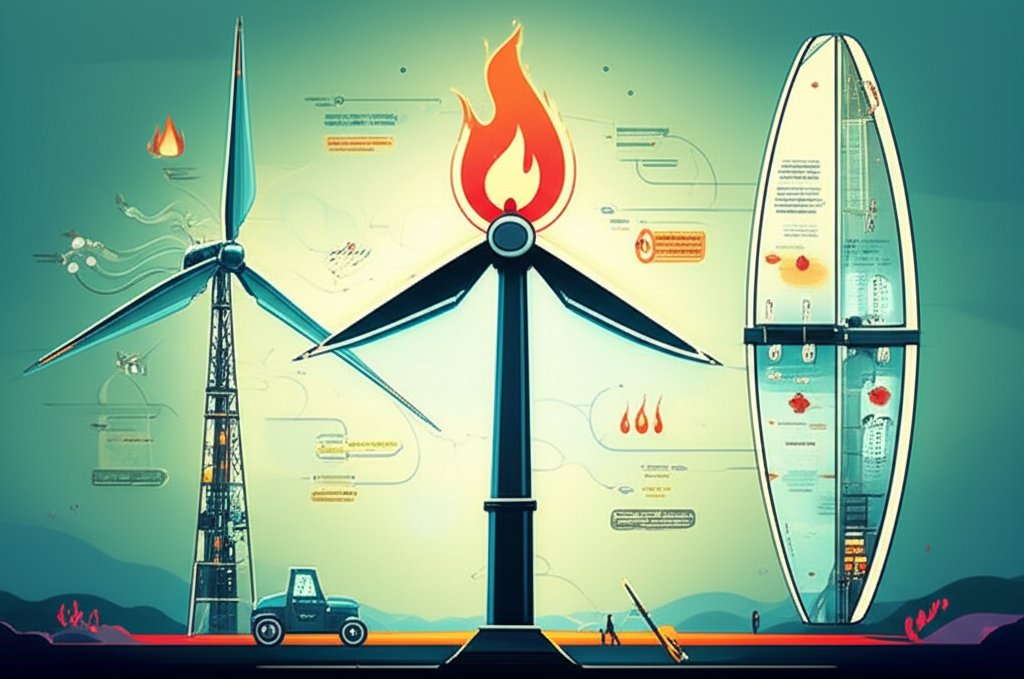Untuk gambaran yang lebih besar dan konteks penuh, pastikan Anda membaca panduan utama kami tentang Vertical Axis Wind Turbine Design: Improving Efficiency and Overcoming Limits.
markdown
The flicker of innovation in renewable energy is often shadowed by concerns, and the specter of wind turbine fire is one that sparks immediate debate. From remote fields to offshore installations, ensuring turbine safety is paramount as we strive for sustainable energy solutions.
At a glance:
- Understand the key fire risks specific to both horizontal and vertical axis wind turbines.
- Explore fire prevention and suppression strategies tailored for turbine environments.
- Learn about the ongoing research and standards aimed at mitigating wind turbine fire hazards.
- Assess the impact of turbine design (VAWT vs. HAWT) on fire risk and accessibility for firefighting.
Understanding the Landscape of Wind Turbine Fire Risks
While statistically infrequent, wind turbine fires can have significant consequences, ranging from equipment damage and energy generation downtime to environmental impact and potential safety hazards. The risks can arise from a combination of factors related to the turbine’s design, operating environment, and maintenance practices.
Vertical Axis Wind Turbines (VAWTs), while less prevalent than Horizontal Axis Wind Turbines (HAWTs), present a unique set of considerations. Their design, with key components often located closer to the ground, can influence both the ignition sources and the accessibility for fire suppression.
Here’s a breakdown of common ignition sources and risk factors:
- Electrical faults: Short circuits, cable insulation breakdown, and component failure are major culprits. These can be exacerbated by harsh weather conditions and the constant vibration inherent in turbine operation.
- Mechanical failures: Gearbox malfunctions (more common in HAWTs), bearing failures, and brake malfunctions can generate excessive heat, potentially igniting lubricants or other flammable materials.
- Lightning strikes: Wind turbines, by their nature, are exposed to lightning. Effective lightning protection systems are crucial, but even with these systems in place, strikes can still initiate fires.
- Hydraulic fluid leaks: Hydraulic systems are used for pitch control (primarily in HAWTs) and braking. Leaks can create a flammable mist that can easily ignite.
- Maintenance errors: Improper maintenance procedures, such as inadequate lubrication or faulty electrical work, can increase the risk of fire.
VAWTs vs. HAWTs: How Design Influences Fire Risk

The fundamental difference in design between Vertical and Horizontal Axis Wind Turbines influences their fire risk profiles.
| Feature | Horizontal Axis Wind Turbine (HAWT) | Vertical Axis Wind Turbine (VAWT) |
|---|---|---|
| Generator & Gearbox | Located high in the nacelle; difficult to access. | Located at or near ground level; easier to access. |
| Blade Pitch System | Hydraulic systems common; potential for fluid leaks. | Often simpler or absent, reducing hydraulic risk. |
| Height | Generally taller, increasing lightning strike risk. | Generally shorter, potentially reducing lightning risk. |
| Maintenance | More challenging due to height and nacelle location. | Potentially easier due to ground-level component access. |
| VAWTs offer some potential safety advantages due to the accessibility of their components at ground level. Maintenance and inspections are often simpler, which can help in proactively identifying and addressing potential fire hazards. However, both types of turbines need robust fire protection strategies. To understand the efficiency and design choices of Vertical Axis Wind Turbines, you can Learn about Vertical Axis Turbines. |
Layers of Defense: Fire Prevention and Suppression Strategies
A comprehensive fire safety plan for wind turbines includes both proactive prevention measures and reactive suppression systems.
Fire Prevention:
- Regular Inspections: Conduct thorough visual and thermal inspections of all critical components, including electrical systems, gearboxes, and hydraulic systems.
- Maintenance Programs: Implement and strictly adhere to preventative maintenance schedules, including lubrication, filter replacements, and electrical system checks.
- Lightning Protection: Ensure lightning protection systems are properly installed, tested, and maintained in accordance with relevant standards (e.g., IEC 61400-24).
- Cable Management: Proper cable routing and securing to prevent chafing and insulation damage, reducing the risk of electrical faults.
- Temperature Monitoring: Install temperature sensors in critical areas (e.g., generator, gearbox) to detect overheating conditions early.
- Fluid Leak Detection: Utilize sensors to detect hydraulic fluid leaks promptly, allowing for timely intervention.
- Training: Ensure personnel are adequately trained in fire safety procedures, including the use of fire suppression equipment and emergency response protocols.
Fire Suppression: - Automatic Fire Suppression Systems: Install automated fire suppression systems in the nacelle (for HAWTs) and around critical components of VAWTs, using agents appropriate for electrical and flammable liquid fires (e.g., FM-200, CO2, or dry chemical). Considerations for VAWTs should focus on the generator and control systems.
- Remote Monitoring: Implement remote monitoring systems to detect fire events and alert emergency responders automatically.
- Fire-Resistant Materials: Use fire-resistant materials in the construction of nacelles and enclosures to slow the spread of fire.
- Accessibility: Ensure clear access routes for emergency responders, particularly in remote locations.
- Water Supply: Consider on-site water storage or access to a reliable water source for firefighting, especially for larger wind farms. Note that water may not be suitable for electrical fires until the system is de-energized.
Example: A wind farm operator in California implemented a condition monitoring system that detected abnormal vibration in a gearbox. Upon inspection, overheating was discovered, preventing a potential fire. The early detection allowed for a controlled shutdown and repair, averting significant damage and downtime.
Navigating Evolving Standards and Ongoing Research
The wind energy industry is constantly evolving, and so are the standards and research related to wind turbine fire safety.
- IEC 61400-Series: The International Electrotechnical Commission (IEC) 61400 series of standards provides guidance on various aspects of wind turbine design, safety, and testing, including lightning protection and fire safety.
- NFPA Standards: The National Fire Protection Association (NFPA) develops standards related to fire protection in various industries, including wind energy.
- Research Initiatives: Ongoing research focuses on improving fire detection and suppression technologies, developing fire-resistant materials, and understanding the specific fire risks associated with different turbine designs and operating environments.
- Collaboration: Collaboration between turbine manufacturers, wind farm operators, fire safety experts, and regulatory agencies is crucial for advancing fire safety in the wind energy industry.
Staying up-to-date on the latest standards and research is essential for ensuring the effectiveness of fire prevention and suppression strategies.
Practical Playbook: Immediate Steps for Enhanced Safety

Here’s a checklist to get started in improving wind turbine fire safety:
- Risk Assessment: Conduct a comprehensive risk assessment to identify potential fire hazards specific to your wind turbine(s), considering both VAWT and HAWT designs.
- Inspection Protocol: Refine or implement regular inspection protocols with trained personnel, including thermal imaging and visual checks of key components.
- Maintenance Schedule: Review and optimize the preventative maintenance schedule, ensuring timely lubrication, filter replacements, and electrical system checks.
- Emergency Plan: Develop a detailed emergency response plan that includes procedures for fire detection, evacuation, and communication with emergency responders.
- Suppression Systems: Evaluate the adequacy of existing fire suppression systems and consider upgrades or additions based on the risk assessment.
- Training Refresher: Conduct regular fire safety training for all personnel involved in turbine operation and maintenance.
- Documentation Review: Ensure up to date documentation on all maintenance and incidents are readily accessible for auditing.
- Compliance Audit: Perform an audit ensuring compliance to local and federal guidelines.
Quick Answers: Addressing Common Questions About Turbine Fire
Q: Are wind turbine fires common?
A: Statistically, wind turbine fires are relatively rare compared to the total number of operating turbines. However, the potential consequences can be significant, making prevention and mitigation crucial.
Q: What is the most common cause of wind turbine fires?
A: Electrical faults and mechanical failures, particularly in gearboxes, are leading causes of wind turbine fires. Lightning strikes are also a significant risk.
Q: Are VAWTs safer than HAWTs in terms of fire risk?
A: VAWTs may offer some advantages due to easier ground-level access to components, potentially simplifying maintenance and firefighting. However, both types of turbines require robust fire protection strategies.
Q: Can wind turbine fires be extinguished?
A: Yes, wind turbine fires can be extinguished, but it often requires specialized equipment and trained personnel. Automatic fire suppression systems can play a crucial role in controlling fires in their early stages.
Q: What type of fire suppression system is best for wind turbines?
A: The best type of fire suppression system depends on the specific risks and characteristics of the turbine. Common options include FM-200, CO2, and dry chemical systems, each with its own advantages and disadvantages.
Actionable Close: Taking Control of Turbine Fire Safety
Wind turbine fire safety is not a static issue; it demands proactive planning, continuous monitoring, and a commitment to staying informed about the latest technologies and best practices. Assessing the risks, implementing prevention strategies, and having effective suppression systems in place are vitally important to protecting your investment and, more importantly, ensuring the safety of personnel and the environment.
- Water Mill Electricity Generator Provides Free Home Power - December 16, 2025
- Water Wheel Electric Generator Provides Free Home Electricity - December 15, 2025
- Choosing the Right Portable Hydro Turbine for Your Needs - December 14, 2025
















